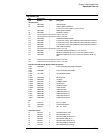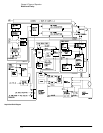
Chapter 8: Theory of Operation
Block-Level Theory
8–5
SVGA Display Card
The SVGA Display Card controls the flat-panel display monitor. There are two major video paths
on this board. The first is used by the system controller on the motherboard to draw all general
display elements, including the grid, status indicators, and toolbars and menus for the graphical
interface. This is handled through a standard VGA chip, BIOS, and DRAM, similar to a standard
PC VGA interface. The other path is the video input from the scope interface board, which is
multiplexed with the main video to produce the video signals for the flat-panel display. The video
from the scope interface board is the waveform display data. The second path is used to provide
the fastest possible display update rate, which would not be possible through the standard bus
interface to the display controller.
GPIB Interface Card
The GPIB Interface card provides IEEE-488.2 standard bus services for the oscilloscope. The
card interfaces the bus to the motherboard system controller, allowing the system controller to
receive and process GPIB commands and return data to the bus. The circuit consists of three
main compon ent s. The GPIB contro ller provid es an interface betw een the micro pro cessor system
and the GPIB in accordance with IEEE 488 standards. An 8-bit data buffer and 8-bit control line
buffer connect the GPIB controller to the GPIB bus. The GPIB is a 24-conductor shielded cable
carrying 8 data lines, 8 control lines, 7 system grounds, and 1 chassis ground.
Probe Power and Control
The Probe Power and Control board provides filtered, regulated power to the front-panel
AutoProbe interface. It also provides serial communications capability , offset and probe
detection and identification circuitry. All of these are interfaced to the probe through the
conductive pads surrounding the BNCs. Using the facilities of this board, the Autoprobe interface
can supply power for active probes, notify the oscilloscope operating system when a probe is
connected or disconnected, identify the probe type to the oscilloscope operating system for
automatic configuration, and communicate with the probe to support advanced probe
functionality.


















